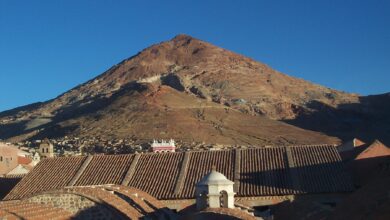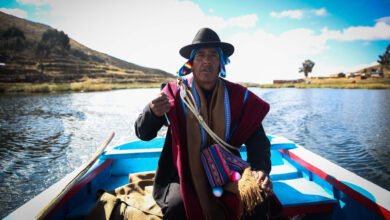Bolivian Cholitas’ Resilience Amidst Vanishing Andean Glaciers
In the Andean peaks, the Cholita climbers, vibrant embodiments of indigenous culture, face the stark realities of climate change, impacting their heritage and livelihood.

Photo: Wikimedia – Yves Picq
The Latin American Post Staff
Escucha este artículo
Leer en español: La resiliencia de las cholitas bolivianas en medio de la desaparición de los glaciares andinos
Cholita Climbers: Scaling Peaks and Preserving Heritage
In the majestic Andean mountains, indigenous Bolivian women, known as the Cholita climbers, have forged a unique path over the past eight years. Dressed in their traditional, colorful, multilayered skirts, these Aymara women have not only been scaling the snowcapped peaks but also serving as tourist guides, showcasing the beauty of their homeland. Their journey, however, is more than a tale of adventure; it's a narrative deeply entwined with the cultural significance of the Cholitas and the alarming impact of climate change on their way of life.
Cholita culture is an integral part of Bolivia's rich heritage, representing the resilience and strength of indigenous women. The term 'Cholita' was once derogatory and used against indigenous or mixed-heritage women. Still, it has been reclaimed as a symbol of pride and identity. Cholitas are known for their distinctive and colorful attire, particularly their bowler hats and layered skirts, adapted to mountaineering. This cultural adaptation is a statement of identity and a reclamation of space, often denied to indigenous groups.
A Melting Reality: Cholitas Confronting Climate Change
Their literal and metaphorical ascent began with ice crunching under their crampons. In recent years, however, these sounds have been replaced by the unsettling noise of melted water running beneath their feet, a stark reminder of the changing environment. The Cholitas have witnessed first-hand the alarming retreat of glaciers in Bolivia, a direct consequence of global warming. This environmental crisis poses a significant threat to their livelihood and the preservation of their cultural practices.
The Huayna Potosi mountain, a towering 6,000m peak near the Bolivian city of El Alto, symbolizes the Cholitas' strength. But this symbol is in peril. Over the past two decades, the mountain has been diminishing, its icy facade receding to expose bare rocks. This change is part of a more significant, disturbing trend across Bolivia. In the last 30 years, the country's glaciers have lost 40% of their volume, a staggering statistic that underscores the urgency of climate change.
The impact is profound and multifaceted. Once blanketed in ice, the lower parts of these mountains now lay bare. The loss of Chacaltaya, a 5,400m mountain and former popular ski resort, is a poignant example of this environmental catastrophe. For the Cholitas, this means traveling further up the hills to find ice. This endeavor is not only more challenging but also less appealing to tourists, thereby affecting their income. The decrease in tourism has had a tangible impact on their earnings, with a noticeable drop from US$50 to US$30 per tour.
Adapting and Preserving: Cholitas Navigating Change
The decline in their guiding business has been alarming. While the previous year saw them conduct 30 tours during the September-to-December climbing season, the numbers have nearly halved recently. This downturn has compelled these resilient women to seek alternative sources of income. Some have turned to their rich cultural heritage, crafting and selling blankets and coats made from alpaca wool, a resource abundant in the Andes.
Also read: Bolivia's Diplomatic Break with Israel: A Historical Analysis of Geopolitical Alignments and Shifts
The story of the Cholita climbers is a poignant reminder of the interconnectedness of culture, environment, and economy. As they continue to climb higher, both in the mountains and in their fight against adversity, they stand as a testament to the enduring spirit of the Aymara people and the urgent need to address the global challenge of climate change. Their journey is not just about the ascent of peaks; it's about preserving a way of life, celebrating cultural identity, and fighting for survival in a rapidly changing world.




